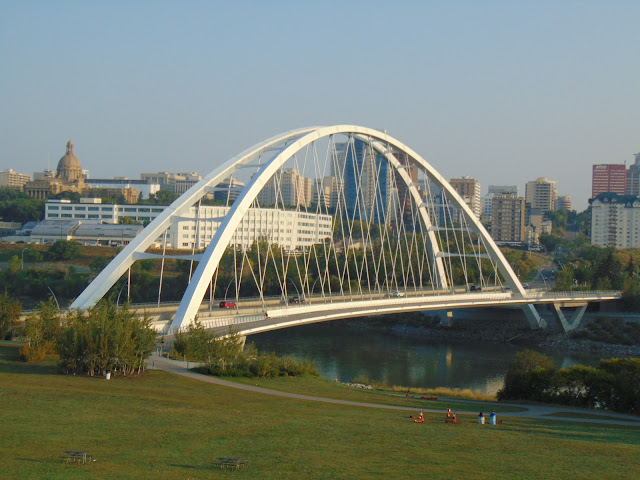Located in Edmonton, Alberta, the Walterdale Bridge was opened in 2017 and carries northbound traffic across the North Saskatchewan River from Queen Elizabeth Park into the Rossdale neighborhood and downtown Edmonton. Named for an early area settler and local ferry operator by the name of John Walter, the bridge replaced the first Walterdale Bridge, which was a steel truss built in 1913. Southbound traffic going across the river takes the nearby High Level Bridge. The bridge has also become a feature in Edmonton's skyline.
Construction on the $155 million project began in 2013. The new 755-foot-long (230.1-meter-long) Walterdale Bridge features a signature arch structure, at more than 160 feet tall (48.75 meters), which serves as a gateway to Edmonton's downtown for motorists, cyclists, and pedestrians. The bridge features a double metal arch bridge with an inward-slanting arch towards its apex. As the Walterdale Bridge is located on parkland, it was a simple decision to build the current bridge right next to the old bridge. It was decided to increase the capacity of the new Walterdale Bridge compared to the old one, increasing it from two lanes to three lanes in a single direction, and a pedestrian walkway, with the option to widen the deck and create a fourth lane in the future, presenting plenty of options to improve traffic flow as the needs of Edmonton's transportation network evolves.
 |
| A view of the Walterdale Bridge in the early morning light. |
 |
| The Walterdale Bridge has prominence among Edmonton's skyline from this knoll at Queen Elizabeth Park. |
 |
| Another view of the Walterdale Bridge from Queen Elizabeth Park. The Alberta Legislative Building is towards the left of the photo. |
 |
| A northbound view of the Walterdale Bridge. |
How to Get There:
Sources and Links:
City of Edmonton - Walterdale Bridge
Kebony - Walterdale Bridge
Acconia - Walterdale Bridge
HistoricBridges.org - Walterdale Bridge
Acconia - The Walterdale bridge: a major engineering feat that enhances a city
Global News - Edmonton mulls Walterdale Bridge 2-way traffic flow changes amid upcoming construction


Comments